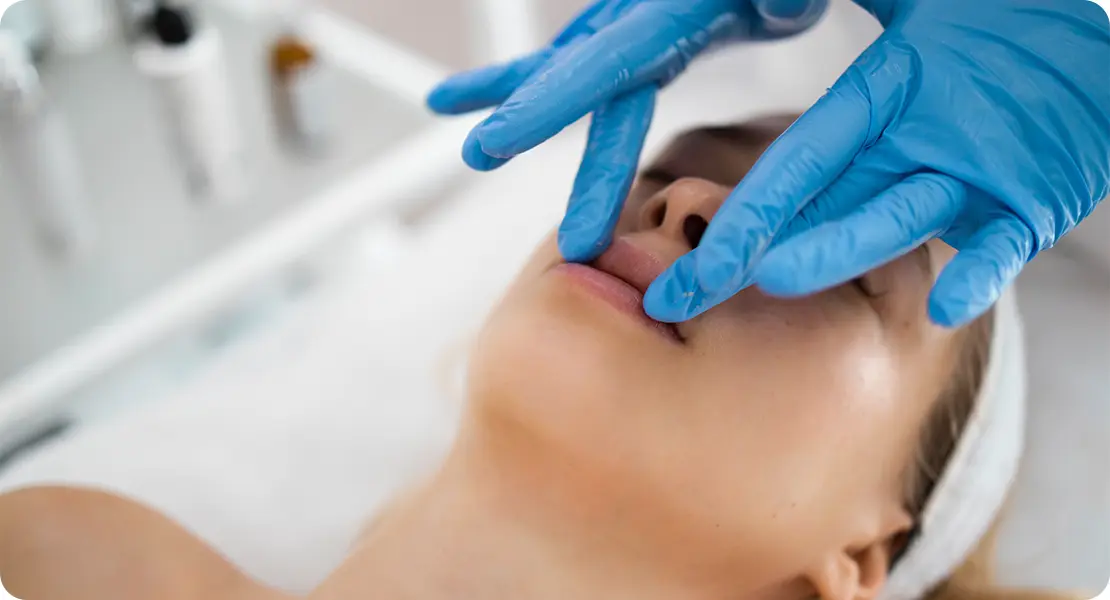Have you noticed dark lines or patches on your lips that weren’t there before? Whether they’re faint streaks, spots, or a general darkening of the lip tone, these changes can be concerning especially since your lips are one of the most visible features of your face.
The truth is, dark lines on the lips are quite common and often harmless. However, they can also indicate changes in pigmentation, lifestyle factors, or even certain medical conditions. Understanding what’s behind them is the first step to treating them effectively.
In this guide, we’ll break down the most common causes of dark lines on lips, when you should see a dermatologist, and the professional treatments available to help restore your natural, even lip tone.
Why Do Lips Change Colour?
Your lips get their pinkish or reddish tone from the fine blood vessels just beneath the surface. Unlike the rest of your skin, the lips have less melanin the pigment that gives colour to your skin and protects it from UV rays.
When melanin production increases or becomes uneven, hyperpigmentation can occur. This results in darker areas or visible lines across the lips.
These pigmentation changes can be triggered by various factors from lifestyle habits like smoking to medical conditions or simple ageing.
Common Causes of Dark Lines on Lips

Let’s look at the main reasons why these lines appear and what you can do about them.
1. Sun Exposure (Lip Hyperpigmentation)
The most common cause of dark lines on lips is sun damage. Just like your face and hands, your lips are constantly exposed to UV rays but they’re often forgotten when it comes to sun protection.
UV light stimulates melanin production in the skin as a defence mechanism. Over time, this can lead to patches or streaks of pigmentation on the upper or lower lip.
Signs:
- Uneven lip colour
- Brown or greyish lines
- Dry, rough lip texture
How to prevent it:
- Use an SPF 30+ lip balm daily, even on cloudy days.
- Reapply every few hours, especially after eating or drinking.
- Avoid tanning beds or direct sun exposure during peak hours.
If the pigmentation is already present, a dermatologist can recommend safe depigmenting treatments to help fade the dark lines.
2. Smoking
Cigarette smoking is another leading cause of dark lips and lines. The nicotine and tar in tobacco not only stain the lips directly but also reduce oxygen flow to the skin, making it appear dull and darker.
Additionally, the heat from cigarettes and repetitive lip movements contribute to fine lines around the mouth.
How smoking affects the lips:
- Darkening or greyish discolouration
- Dryness and cracking
- Fine vertical lines (“smoker’s lines”)
Solution:
Quitting smoking can gradually allow your lips to regain their natural tone. Exfoliating gently and using lip balms rich in vitamin E or shea butter can also help with repair. For stubborn pigmentation, professional treatments can significantly lighten dark areas.
3. Dehydration and Lip Dryness
When your lips become dry and chapped, they often appear darker or uneven. The cracks may look like faint lines, which are mistaken for pigmentation.
Lack of moisture strips away the natural protective barrier of the lips, making them vulnerable to damage and discolouration.
How to fix it:
- Stay hydrated throughout the day.
- Use a moisturising lip balm containing hyaluronic acid, ceramides, or lanolin.
- Avoid licking your lips it dries them further.
If your lips frequently dry out or peel, it could be due to environmental factors or a reaction to certain lip products.
4. Allergic Reactions (Lip Contact Dermatitis)
Sometimes, the culprit is your own lipstick, toothpaste, or lip balm. Ingredients like artificial dyes, fragrances, or preservatives can cause an allergic reaction known as contact dermatitis.
This may result in irritation, redness, and eventually darker patches as the skin heals unevenly.
What to look out for:
- Burning or tingling after applying lip products
- Flaky or swollen lips
- Dark spots that linger after inflammation
Switch to hypoallergenic and fragrance-free products, and see a dermatologist for patch testing to identify allergens.
5. Hormonal Changes and Melasma
Hormonal fluctuations especially during pregnancy, menopause, or due to birth control pills can trigger melasma, a pigmentation disorder.
While melasma usually affects the cheeks and forehead, it can sometimes appear on the lips as brownish patches or lines.
Treatment options include:
- Topical creams with azelaic acid, niacinamide, or hydroquinone
- Chemical peels (performed by professionals)
- Laser therapy for resistant cases
If you suspect hormones are playing a role, your dermatologist may tailor your treatment accordingly.
6. Iron or Vitamin Deficiencies
Low levels of iron, vitamin B12, or folate can lead to paleness or darker discolouration of the lips.
These nutrients are essential for healthy blood circulation and skin repair. When deficient, your lips may appear dull or show patchy pigmentation.
What you can do:
- Eat iron-rich foods like spinach, lentils, and red meat.
- Take a multivitamin if recommended by your doctor.
- Get regular blood tests if you experience fatigue, dizziness, or brittle nails along with lip discolouration.
7. Medications
Certain prescription drugs can cause pigmentation changes as a side effect.
These include:
- Antimalarial medications
- Some antibiotics (like minocycline)
- Chemotherapy drugs
- Anticonvulsants
If you’ve recently started a new medication and notice dark lines on your lips, speak to your healthcare provider before stopping or switching your prescription.
8. Post-Inflammatory Hyperpigmentation (PIH)
If you’ve had lip irritation from burns, cold sores, or even chapped lips the healing process can leave behind darker patches.
This condition, called post-inflammatory hyperpigmentation, happens when the skin produces excess melanin in response to inflammation.
Good news:
PIH is not permanent. With proper care and treatment, the dark marks fade gradually over weeks or months.
9. Caffeine and Lifestyle Factors
Excessive caffeine intake, poor sleep, and stress can also dull your skin and lips over time. Coffee and tea contain tannins, which may temporarily stain the lips, especially if hydration is lacking.
Aim for moderation and keep your body hydrated to maintain healthy skin tone.
10. Underlying Health Conditions
Though rare, persistent dark lines on lips can be linked to certain medical conditions, such as:
- Addison’s disease (adrenal insufficiency)
- Laugier-Hunziker syndrome (a benign pigmentation disorder)
- Peutz-Jeghers syndrome (a genetic condition with freckling around the mouth)
If pigmentation appears suddenly or is accompanied by other symptoms (fatigue, weight loss, hormonal changes), consult your doctor or a dermatologist immediately.
When to See a Dermatologist

While many causes of lip pigmentation are harmless, you should book a consultation with a dermatologist if:
- The dark lines appear suddenly or spread quickly.
- They’re accompanied by dryness, cracking, or sores.
- You’ve tried home remedies without improvement.
- You suspect an allergy or reaction to a cosmetic product.
A dermatologist can assess whether your pigmentation is superficial or deeper within the skin layers and recommend treatments accordingly.
Professional Treatments to Lighten Dark Lines on Lips
Depending on the cause and severity, several safe and effective dermatological treatments can help restore even-toned lips.
1. Topical Depigmenting Creams
These are prescription creams that help reduce melanin production and fade dark areas gradually.
Common ingredients include:
- Hydroquinone (used under professional guidance)
- Kojic acid
- Azelaic acid
- Vitamin C
- Licorice extract
A dermatologist may recommend a combination of these for best results, often paired with a mild exfoliant.
2. Chemical Peels
A light chemical peel designed for sensitive areas can help exfoliate dead skin cells and speed up pigment removal.
Peels with lactic acid, glycolic acid, or mandelic acid are commonly used for lip and perioral pigmentation.
Note: Always have this performed by a qualified dermatologist over-the-counter or DIY peels can damage the delicate lip area.
3. Laser Treatments
Laser therapy is one of the most effective ways to target deep pigmentation.
Q-switched Nd:YAG lasers or fractional lasers can break down melanin clusters without harming the surrounding tissue.
Sessions are typically spaced 3–4 weeks apart and yield progressive lightening.
4. Microneedling
This involves using fine needles to create microchannels in the skin, stimulating collagen production and enhancing the absorption of brightening serums.
It can improve both pigmentation and texture, making the lips appear smoother and more youthful.
5. Lip Exfoliation and Brightening Treatments
Some clinics offer lip polishing or hydrating facials that combine gentle exfoliation with nourishing serums to revitalise dull, pigmented lips.
These non-invasive treatments are great for maintenance and hydration between professional sessions.
Home Remedies and Preventive Care
While professional treatments offer faster results, consistent at-home care can support long-term improvement.
1. SPF Lip Balm
Use one every day ideally with broad-spectrum SPF 30 or higher. Reapply after meals or drinks.
2. Hydration
Drink enough water to keep your lips plump and healthy. Dehydrated lips tend to appear darker and more wrinkled.
3. Avoid Smoking and Excessive Caffeine
Both dehydrate your lips and contribute to dullness.
4. Gentle Lip Scrubs
Use a mild sugar-and-honey scrub once or twice a week to remove dead cells. Avoid harsh scrubbing, which can worsen pigmentation.
5. Vitamin-Rich Lip Care
Look for lip balms or oils containing vitamin E, C, or rosehip oil, which support healing and brighten skin tone naturally.
Can Lip Pigmentation Be Prevented?
Yes prevention largely comes down to protection and lifestyle.
Here’s what dermatologists recommend:
- Always apply SPF before stepping outdoors.
- Remove makeup before bed.
- Eat foods rich in antioxidants and vitamins.
- Avoid licking your lips it dries and irritates them.
- Keep your lips moisturised, especially in winter.
By keeping these habits consistent, you’ll not only prevent pigmentation but also maintain soft, smooth lips year-round.
Myths About Dark Lips and Pigmentation
Myth 1: Lemon juice or toothpaste can lighten lips.
Fact: These DIY “hacks” are acidic and can irritate your skin, worsening pigmentation.
Myth 2: Lip pigmentation means you have a disease.
Fact: Most cases are harmless and cosmetic. Only a dermatologist can confirm if it’s medical.
Myth 3: Once lips darken, they can’t return to normal.
Fact: With proper treatment and care, lip pigmentation can be significantly reduced or reversed.
How Long Does It Take to See Results?
The timeline depends on what’s causing the pigmentation and how deeply it’s rooted in the skin.
- Mild dryness or sun pigmentation: 2–4 weeks with proper care.
- Post-inflammatory marks: 1–3 months.
- Deep pigmentation: 3–6 months with professional treatment.
Consistency is key skipping sun protection or using irritating lip products can delay progress.
FAQs About Dark Lines on Lips
1. Are dark lines on my lips something to worry about?
You don’t need to panic if you notice dark lines or patches on your lips, as they are often harmless and caused by lifestyle factors, sun exposure, or minor pigmentation changes. However, if they appear suddenly, spread quickly, or are accompanied by other symptoms, it’s wise to check in with a dermatologist.
2. Can sun exposure really darken my lips?
Yes, your lips are exposed to UV rays just like the rest of your skin, and without proper sun protection, melanin production can increase, causing uneven colour or dark lines. Using a lip balm with SPF every day helps protect your lips from these changes.
3. Does smoking actually cause lip pigmentation?
Absolutely. Smoking introduces chemicals like nicotine and tar, which can stain your lips and reduce blood flow, making them look darker. Over time, repeated heat and lip movements from smoking can also lead to fine lines around your mouth.
4. Can dehydration or dry lips make them darker?
Yes, when your lips are dry or chapped, they can appear darker and uneven. Dryness can exaggerate fine lines and patches, so keeping your lips moisturised and staying hydrated is essential to maintaining a healthy colour.
5. Could my hormones be affecting my lip colour?
Hormonal changes, such as those during pregnancy, menopause, or when using birth control, can trigger melasma, which sometimes appears on the lips. These hormonal fluctuations can lead to brownish patches or lines that may need professional assessment for proper treatment.
6. Are vitamin or iron deficiencies linked to dark lips?
They can be. Low levels of iron, vitamin B12, or folate affect circulation and skin repair, which may cause your lips to appear dull or uneven. If you notice additional symptoms like fatigue or brittle nails, a blood test and dietary adjustments could help.
7. Can medications make my lips darker?
Yes, certain medications, including some antibiotics, antimalarials, and chemotherapy drugs, can cause pigmentation changes. If you’ve recently started a new prescription and notice dark lines on your lips, it’s best to discuss it with your healthcare provider rather than stopping the medication on your own.
8. Will post-inflammatory hyperpigmentation from a cold sore go away?
It usually will. When your lips heal from irritation, burns, or cold sores, extra melanin can temporarily create darker patches. With consistent care and protection, these marks generally fade over a few weeks or months.
9. Can lifestyle habits like caffeine or poor sleep affect my lips?
Yes, excessive caffeine, stress, and lack of sleep can make your lips look dull over time. Tannins in coffee and tea can temporarily stain lips, and dehydration or fatigue can exacerbate uneven pigmentation. Maintaining healthy habits can help keep your lips vibrant.
10. What’s the best way to get rid of dark lines on my lips?
The approach depends on the cause. For mild pigmentation, daily sun protection, hydration, and gentle lip care can make a noticeable difference. For deeper or persistent dark lines, a dermatologist can offer treatments such as topical creams, chemical peels, microneedling, or laser therapy to safely restore even lip tone.
Final Thought: Dark Lines and Lip Pigmentation
Dark lines or patches on your lips can feel concerning, but in most cases, they’re harmless and manageable with the right care. By protecting your lips from sun exposure, staying hydrated, and avoiding habits like smoking or excessive caffeine, you can prevent many common causes of pigmentation.
If you’ve tried home remedies and still notice persistent or worsening dark lines, it’s a good idea to seek professional advice. You can book a consultation with one of our dermatologists by contacting us at the London Dermatology Centre, who can assess your lips and recommend safe, effective treatments tailored to your needs.
References:
1. Vachiramon, V. (2012) ‘Approaches to the evaluation of lip hyperpigmentation’, Journal of the American Academy of Dermatology, 66(1), pp. 127-133. Available at: https://pubmed.ncbi.nlm.nih.gov/22715817/
2. Thawabteh, A.M. (2023) ‘Skin pigmentation types, causes and treatment a review’, Journal of Clinical and Aesthetic Dermatology, 16(7), pp. 31-39. Available at: https://www.ncbi.nlm.nih.gov/pmc/articles/PMC10304091/
3. Moolla, S. (2022) ‘Dermatology: how to manage facial hyperpigmentation in skin of color’, Journal of Cutaneous Medicine and Surgery, 26(3), pp. 258-265. Available at: https://www.ncbi.nlm.nih.gov/pmc/articles/PMC9165630/
4. Bhatt, S. (2022) ‘Perioral pigmentation’, Pigment International, 9(3), pp. 1-6. Available at: https://journals.lww.com/pigi/fulltext/2022/09030/perioral_pigmentation.2.aspx
5. Jazzar, A. and AlDehlawi, H. (2023) ‘Efficacy and risks of different treatments for oral hyperpigmentation: A systematic review and network meta-analysis’, Journal of Clinical Medicine, 12(20), p. 6567. Available at: https://www.mdpi.com/2077-0383/12/20/6567
